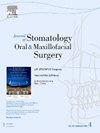Surgically assisted maxillary expansion: Influence of piezosurgery on the complications linked to the midline osteotomy
IF 1.8
3区 医学
Q2 DENTISTRY, ORAL SURGERY & MEDICINE
Journal of Stomatology Oral and Maxillofacial Surgery
Pub Date : 2025-01-30
DOI:10.1016/j.jormas.2025.102258
引用次数: 0
Abstract
Transverse maxillary deficiency requires surgical maxillary expansion when the midpalatal suture is closed. The midline osteotomy of the maxilla can lead to significant dental, gingival and bone complications. Technically, this osteotomy is usually performed using osteotomes, a burr or an oscillating saw, but is increasingly being replaced by piezosurgery. There are no published studies on the impact of piezoelectric devices on complications.
This study tries to evaluate complications after median inter-incisors osteotomy (gingival recession, tooth loss, bone loss) with piezosurgery, and then to compare them with complications associated with osteotomes.
A single-center retrospective study of 57 patients who underwent surgical maxillary expansion was conducted. Dental complications (mobility, color and loss), gingival and papilla recession and bone defect were assessed before and at least 6 months after surgery. Two groups were compared: the piezosurgery P group (49 patients) and the osteotomes O group (8 patients).
In piezosurgery group, 16.3 % of patients developed central papilla recession and 8 % bone defect, against 12.5 % and 0 % respectively in osteotomes group. No statistically significant difference was found between both groups in the incidence of gingival or bone complications.
手术辅助上颌扩张:压电手术对中线截骨并发症的影响。
上颌横向缺损需要在关闭中腭缝线时进行上颌扩张手术。上颌中线截骨术会导致严重的牙齿、牙龈和骨骼并发症。从技术上讲,这种截骨术通常使用截骨器、毛刺或振荡锯进行,但越来越多地被压电手术所取代。关于压电装置对并发症影响的研究尚未发表。本研究试图评估中门牙间截骨术后的并发症(牙龈萎缩、牙齿脱落、骨质流失),并将其与截骨术相关的并发症进行比较。本文对57例接受上颌扩张手术的患者进行了单中心回顾性研究。术前和术后至少6个月评估牙齿并发症(活动性、颜色和缺失)、牙龈和乳头萎缩以及骨缺损。比较两组:P组(49例)和O组(8例)。骨组织手术组出现中央乳头萎缩的比例为16.3%,骨缺损的比例为8%,而截骨术组分别为12.5%和0%。两组牙龈或骨骼并发症的发生率无统计学差异。
本文章由计算机程序翻译,如有差异,请以英文原文为准。
求助全文
约1分钟内获得全文
求助全文
来源期刊

Journal of Stomatology Oral and Maxillofacial Surgery
Surgery, Dentistry, Oral Surgery and Medicine, Otorhinolaryngology and Facial Plastic Surgery
CiteScore
2.30
自引率
9.10%
发文量
0
审稿时长
23 days
 求助内容:
求助内容: 应助结果提醒方式:
应助结果提醒方式:


